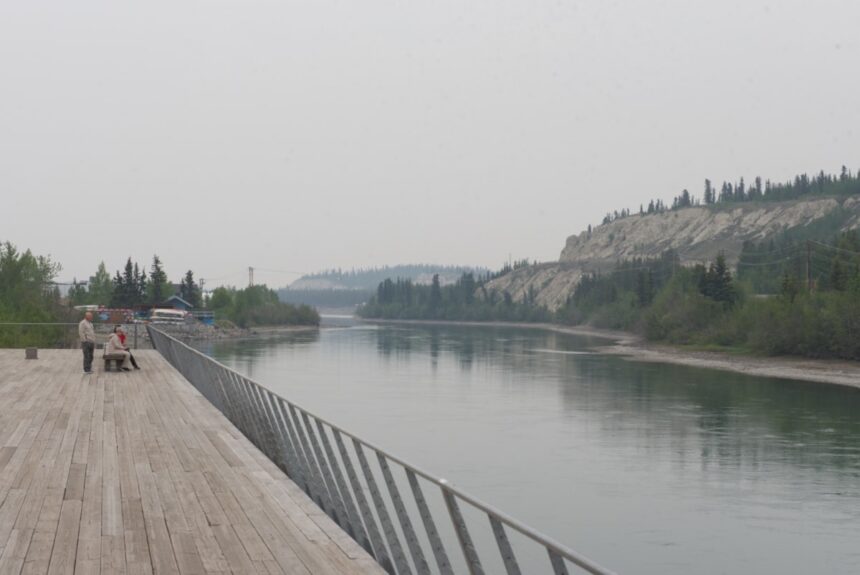The acrid smell of smoke hangs in the air as I step onto my balcony in downtown Vancouver. The mountains that normally frame the city have disappeared behind a curtain of haze. It’s the third summer in a row where wildfire smoke has become an unwelcome seasonal companion across much of Canada.
Last week in Whitehorse, I watched as parents debated whether to let their children play outside while the Air Quality Health Index hovered at 7 – well into the high-risk category. One mother, Ellen Maki, told me she’s developed a “smoke ritual” for her family.
“We’ve got air purifiers in every room now,” she said, adjusting her 4-year-old daughter’s mask. “Three years ago, I’d never have imagined keeping a chart of PM2.5 readings on our fridge.”
Ellen isn’t alone. As wildfires increase in frequency and intensity across Canada, communities are adapting to a new reality where smoke can linger for weeks. The health implications are substantial but often misunderstood.
Dr. Sarah Henderson, scientific director of environmental health at the British Columbia Centre for Disease Control, explains that wildfire smoke contains a complex mixture of gases and fine particles that can penetrate deep into the lungs.
“The particulate matter in wildfire smoke – especially PM2.5 – is small enough to get past our body’s natural defenses,” she tells me over the phone. “When we talk about the health effects, we’re mostly concerned about these tiny particles that can trigger inflammation in the lungs and potentially throughout the body.”
Recent research from the Canadian Medical Association Journal shows emergency room visits for respiratory issues can increase by 10-20% during heavy smoke events. The study tracked hospital admissions across British Columbia during the record-breaking 2017 and 2018 wildfire seasons, finding significant increases in asthma attacks, COPD exacerbations, and respiratory infections.
But smoke affects more than just the lungs. A 2021 study published in Environmental Health Perspectives found associations between wildfire smoke exposure and increased ambulance calls for cardiac events. The connection makes sense: when fine particles enter the bloodstream, they can trigger inflammation that affects blood vessels and heart function.
Walking through Dease Lake in northern BC last month, I met Gerald Amos, a 72-year-old elder from the Haisla Nation who has lived off the land his entire life. As we sat by the shore, visibility reduced to less than a kilometer by smoke, he reflected on the changes he’s witnessed.
“We’ve always had forest fires, but not like this,” he said, his voice slightly hoarse. “The elders in my community, the pregnant women, the little ones – they’re suffering the most. Some families are talking about moving south, away from the territories we’ve called home for thousands of years.”
Gerald’s observations align with what health experts identify as vulnerable populations. According to Health Canada, those most at risk from wildfire smoke include people with pre-existing heart or lung conditions, pregnant women, children, seniors, and outdoor workers.
In Prince George, community health nurse Leanne Dutchak has been working with local schools to develop “clean air shelters” – designated indoor spaces with enhanced air filtration where vulnerable residents can gather during severe smoke events.
“We’ve had days where the AQHI goes off the charts,” Dutchak explains. “People with asthma or COPD can’t simply stay indoors for weeks at a time. They need safe places to go, especially if they don’t have air conditioning or proper filtration at home.”
The mental health impacts of persistent smoke shouldn’t be underestimated either. Research from the University of Alberta has documented increased rates of anxiety and depression following prolonged wildfire smoke exposure, particularly among those displaced by fires or suffering financial hardship from related disruptions.
When I visited Fort McMurray earlier this summer, psychologist Maya Krishnan described what she calls “climate grief” among her patients.
“There’s this pervasive sense of loss,” she said. “People mourn the clear summer skies they remember from childhood. They worry about their children growing up in a world where breathing clean air outdoors isn’t guaranteed.”
So what can Canadians do to protect themselves? The most effective measure is using HEPA air purifiers indoors. Health Canada recommends creating a “clean air room” in your home during smoke events – typically a bedroom or living space where you spend the most time.
Dr. Henderson suggests a practical approach: “If you can’t afford commercial air purifiers, you can make a DIY version by attaching a furnace filter to a box fan. It’s not perfect, but it can significantly reduce particulate matter indoors.”
When venturing outside becomes necessary, properly fitted N95 masks offer the best protection, though they can be uncomfortable to wear for extended periods. Regular surgical masks provide minimal benefit against the finest particles.
The Canadian government recently launched a national Air Quality Health Index mobile app that provides real-time air quality data and forecasts. Environment and Climate Change Canada has also enhanced its FireWork forecasting system, which predicts smoke movement up to 48 hours in advance.
For communities hit hardest by smoke, adaptation is becoming part of the cultural fabric. In Kamloops, I observed how summer camps now routinely include “smoke days” in their planning, with indoor activities prepared in advance.
Respiratory therapist Jun Wong, who runs asthma clinics throughout interior British Columbia, emphasizes the importance of medication adherence during smoke events.
“If you have asthma or another respiratory condition, make sure your action plan is updated,” Wong advises. “Don’t wait until you’re in distress to use your controller medications.”
As we navigate this new normal, experts stress that long-term policy solutions must address the root causes of increasing wildfire activity. Climate change has created conditions for longer, more intense fire seasons, while forestry practices and urban development also play significant roles.
Back in Vancouver, the sunset glows an eerie orange through the haze. A group of children plays in a splash park, their laughter a reminder that life adapts even under challenging circumstances. Their parents chat nearby, comparing air quality readings on their phones – a new ritual for a changing climate.
As Canadians face more smoke-filled summers ahead, combining individual protective measures with community support systems and evidence-based public health guidance will be essential. The smoke may have become familiar, but we’re still learning how to live with it.






